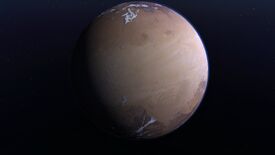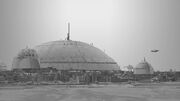
Kharak as it appeared in Homeworld Remastered
Kharak is an Outer Rim desert planet where the Hiigarans were exiled in 6510 GSY. For 3000 years they inhabited this planet. During this time they developed a new civilization, now calling themselves the Kushan.
Kharak is the third of at least five planets in its system.[1]
Geological information[]
| Planetary data[2] | |
|---|---|
| Diameter | 7000 km |
| Circumference | 21,991 km |
| Density | Low |
| Age | 6.7 billion years |
| Hydrographic | 31% |
| Population | 293,050,000 (1110 KDS) |
Kharak is a desert planet, marked by large bands of deserts stretching across the equator, to more temperate, cool climates towards the north and south poles.
Kharak's climate is extremely hot for any inhabited world, ranging near boiling point (100 °C / 212 °F) in the equatorial regions. Closer to the polar regions temperatures are cooler, being almost optimal for human life at the north and south poles.
By 9500 GSY the planet was nearing the end of its geological activity, being 6.7 billion years old. Deserts were spreading and it was only a matter of time until they would cover the poles as well, and all aquifers were drying, which would make it uninhabitable in 2-3 centuries at most.
Kharak does not possess any natural moons, however since 9484 GSY the Scaffold became an artificial moon being over a few kilometers long and visible from the surface of the planet.
Hiigarans on Kharak[]
Main article: Kushan

Tiir, the Northern Coalition capital city, in the northern polar regions of Kharak.
With the arrival of the Hiigarans, the planet was already a desert. Khar-Toba was the first city but harsh conditions forced its inhabitants to abandon it permanently and embark on a deadly walk through the desert to the northern regions of the planet.
A new society, located at the north pole of Kharak, comprised groups of Kiithid, which were loosely related families or clans. The period of 1700 years after The Exile is mostly unknown because no written documents were known to exist. Less than 100 years later Kharakian Dating System was created, and in 178 KDS the greatest wonder of Kharak was created in Lungma Jiin.
In 490 KDS, Kushans reached the south pole which soon become permanently inhabited. Circa 20 years later the greatest military conflict in Kharak history began - the Heresy Wars. Around the sixth century conflicts between the two most powerful kiithid, the Siidim and the Gaalsien nearly resulted in the extinction of the Kushan and the destabilization of Kharak's fragile ecosystem.
Fortunately, Kiith Naabal intervened, uniting all the kiithid under one banner in peace, that of the Daiamid, a governing council that would unite the Kushan for the first time in history. However, the fate of the Kushan people was forever changed with the discovery of the Khar-Toba (1106 KDS) marking the beginning of a new era. Following an accidental discovery of the Khar-Toba by a malfunctioning satellite (originally set to observe the Kharak System, but malfunctioned, scanning Kharak instead) an expedition was launched and the Kushan came to realize their ancient past. However this discovery was marked by blood and conflict, as Kiith Gaalsien launched a major invasion into the lands of the Coalition of the Northern Kiithid, striking as deep as the planetary capital of Tiir before being repulsed. The fighting intensified within the expanse of the Great Banded Desert between the Gaalsien and two surviving Coalition carrier, that managed to reach the fabled city. Following the Coalition's capture of the Khar-Toba, many discoveries regarding the true origin of the Kushan were made and there was now significant evidence of life outside Kharak, prompting the creation of the XenoGenesis Theory. During the conflict with the Gaalsien, the Desert Wars, which lasted decades, many other space derelicts were found beneath the sands of Kharak and the search for them lead to the great advancements in technology which eventually culminated in the Exodus.
Forty years after the Khar-Toba expedition, construction of the Kushan Mothership began. When it was finished and made its first hyperspace jump using the Hyperspace Core found inside Khar-Toba, the Taiidan Empire attacked Kharak using ADWs. At this point all life on Kharak was exterminated, an event that became known as the Kharakian Genocide.

Kharak after being destroyed by the Taiidan Empire.
The Kushan, now without a home, abandoned Kharak after picking up their colonists placed in cryo-sleep and would go on to avenge their world with the destruction of the Taiidan Empire and the reclamation of Hiigara in the subsequent Homeworld War.
The Kushan never returned to Kharak, but was nonetheless revered for the sanctuary it had given the Kushan during their Exile.
Indigenous Fauna[]
In most hot areas near the equator, life is possible only deep underground due to the lethal temperatures at the surface. Outside the equator, especially in the temperate polar climates, there were vegetation and many creatures lived, such as the Skaal beasts and the Fiirkan birds.
Planetary Locations[]
- Tiir: Largest city of the North Pole, founded by Kiith Naabal in 510 KDS. Seat of the Daiamid and capital of the Coalition of the Northern Kiithid.
- Khar-Toba: The first city built in Kharak after the Exile. Was home to the Hiigaran people until the Second Core suffered a failure, leading to its abandonment.
- Saju-ka: Gaalsien temple-city. Destroyed in 717 KDS by Miirpat Gaalsien, leading to his Kiith's fall to extremism.
- Danac: Site of the Battle of Danac of 811 KDS, in which Kiith Naabal slaughtered Kiith Ferriil's army, leading to the latter's absorption by the Siidim.
- Mataar: Major Siidim city/base. Site of the final battle of the Heresy Wars, the Siege of Mataar in 820 KDS.
- Majiir: Largest city in the Southern Pole, and capital city of the Southern Coalition.
- Khontala Mountains, in the North Pole.
- Hameln and Gideo: cities in the Khontala range.
- Great Barrier Mountains: A north pole mountain range that acted as a natural barrier to the Great Banded Desert.
- Sparkling Desert: desert someway in the North Pole.
- Hidden Valley: Location in the north pole, where Tiir was built.
- Great Northern Way: A steam car highway that connected both of Kharak's poles.
- Seas of the Three Sisters: sea or group of these located in the North. Largest source of freshwater for the Kushan.
- Great Banded Desert: equatorial desert.
- Cape Wrath: Site of the first contact between Kiith Siidim and the Kushan.
- Sarathi Basin: Resting place of the Kalash.
- Torin Crater: Artificial crater created by a crash-landing Taiidani carrier.
- Dreamlands: The region in Kharak where Khar-Toba was in, deep within the Great Banded Desert.
- Majiirian Sea, sea in the southern polar region.
- Hunon Mountains: mountains bordering the southern pole.
- Shiiaro Mountains: mountains bordering the White Desert
Trivia[]
- Kharak is similar to Arrakis from Frank Herbert's Dune. Both are barely hospitality desert worlds and they even share a similar name.
